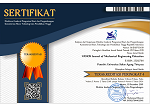Analysis of Corrosion Rate of Carbon Steel Galvanized by Weight Loss Method to Thickness and Micro Structure of Steel
Abstract
This study aims to determine the effect of hot dip galvanizing on steel with different carbon content on mechanical properties of steel. The research method used in this research is an experimental method,The method used was that the metal was coated with hot dip galvanizing media using zinc. From the hardness test results, SAE 1085 produced the highest average of hardness 95.1 HRB. The results of the thickness test showed that the highest AISI 1020 was 131.8 μm. The results of the corrosion rate test showed that the highest corrosion rate is AISI 1020 was 0.36385 mmpy. The microstructure test results showed SAE 1085 has a smaller grain size. Zn layer which is not too thick due to lack of diffusion and movement of Zn atoms due to high carbon content which has a close layer distance and small grains. So that the corrosion rate that occurs is lower than steel which has a low carbon content.
Keywords
Full Text:
PDFReferences
Y. K. Afandi, I. S. Arief, and A. Amiadji, “Analisa Laju Korosi pada pelat baja Karbon dengan Variasi ketebalan coating,” J. Tek. ITS, vol. 4, no. 1, pp. G1-G5., 2015.
F. Y. Hutauruk, “Analisa Laju Korosi pada Pipa Baja Karbon dan Pipa Galvanis dengan Metode Elektrokimia,” Institut Teknologi Sepuluh Nopember, 2017.
M. Nasution, “Karakteristik Baja Karbon Terkorosi Oleh Air Laut,” Bul. Utama Tek., vol. 14, no. 1, pp. 68–75, 2018.
W. Xu et al., “Effects of lanthanum addition on the microstructure and corrosion resistance of galvanized coating,” J. Alloys Compd., pp. 784, 859–868, 2019.
L. Shi et al., “Effect of corrosive media on galvanic corrosion of complicated tri-metallic couples of 2024 Al alloy/Q235 mild steel/304 stainless steel,” J. Mater. Sci. Technol., vol. 35, no. 9, pp. 1886–1893, 2019.
Y. C. Surbakti, “Analisa Laju Korosi Pada Pipa Baja Karbon dan Pipa Baja Galvanis dengan Metode Kehilangan berat,” Institut Teknologi Sepuluh Nopember, 2017.
T. O. Rajagukguk, S. Sumardi, and A. Triono, “Variasi waktu dan temperatur pelapisan hot dip galvanizing terhadap laju korosi serta uji impact material baja karbon rendah (0.02% C).,” Mechanical, vol. 8, no. 1, pp. 14–23, 2017.
Y. Wahyudi, “Analisa Perbandingan Pelapisan Galvanis Elektroplating Dengan Hot Dip Galvanizing Terhadap Ketahanan Korosi Dan Kekerasan Pada Baja,” REM (Rekayasa Energi Manufaktur) J., vol. 1, no. 1, 2016.
P. Shreyas, B. Panda, and R. Kumar, “Mechanical properties and microstructure of 316L-galvanized steel weld,” Mater. Today Proc., vol. 23, pp. 600–607, 2020.
S. Yulianto and I. Aryawidura, “Pengaruh Waktu Tahan Hot Dip Galvanized Terhadap,” SINTEK, vol. 6, no. 2, pp. 33–44, 2015.
M. Ridluwan, “Pengaruh temperatur pencelupan terhadap kekerasan, laju korosi dan struktur mikro pada baja karbon rendah dengan pelapisan metode,” Universitas Negeri Semarang, 2007.
F. A. Alamsyah, P. H. Setyarini, and F. G. MF, “Pengaruh Kekasaran Permukaan Terhadap Ketebalan Lapisan Hasil Hot Dipped Galvanizing (HDG),” Rekayasa Mesin, vol. 3, no. 2, pp. 327–336, 2012.
M. K. Hady, “Studi Pengaruh Kandungan Silikon Hasil Hot Dip Galvanizing,” Universitas Sultan Ageng Tirtayasa, 2016.
D. Erlandhi and I. Ismail, “Analisis Laju Korosi Pada Permukaan Material Baja Komersil Dan Aluminium Dalam Media Air Laut Yang Agitasi,” Universitas 17 Agustus 1945, 2020.
T. Surdia and S. Shinroku, Teknik Pengecoran Logam, 6th ed. Jakarta: PT.Pradnya Paramita, 1999.
DOI: http://dx.doi.org/10.30870/vanos.v6i1.10913
Refbacks
- There are currently no refbacks.

This work is licensed under a Creative Commons Attribution 4.0 International License.


.png)
.png)
